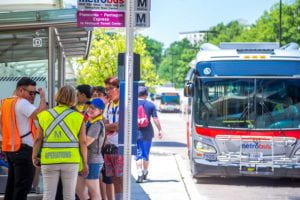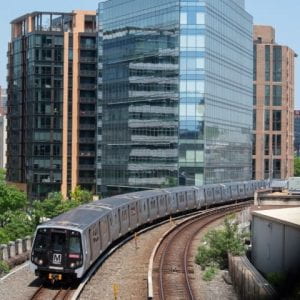By Emma West
Do you commute to an internship each day? What’s your go-to off-campus hangout spot? How do you get around when you leave Foggy Bottom?
DC is a very walkable, bike-friendly city, but when it’s 90 degrees outside or you’re in a hurry to get somewhere, you might ditch your bike (or scooter!) in favor of a Lyft, the free Circulator bus, or Metro. There are many ways to get around the city, some better for the environment than others—so let’s take a moment to think about how sustainability plays into your daily transportation habits.
 Metro customers waiting for Pentagon Express shuttle bus – Summer 2019
Metro customers waiting for Pentagon Express shuttle bus – Summer 2019
The transportation sector currently accounts for the largest percentage of greenhouse gas emissions in the United States at about 30%. Now more than ever, low-carbon transportation needs to be a priority as cities and states turn to real solutions to fight climate change. And there's no doubt that climate change is affecting all of us in the DC region. According to the EPA, "The region has warmed by more than two degrees (F) in the last century, hot days and heavy rainstorms are more frequent, and the tidal Potomac is rising about one inch every eight years." (To read more about the impact of climate change on the District, check out this fact sheet.)
But don’t get too discouraged: you can make a difference! The easiest and most impactful choice you can make each day to live a more sustainable lifestyle is to leave your car at home, forget about your ride-hailing app, and, instead, hop on a Capital Bikeshare bike, get some extra exercise by walking, or take Metro.
 7000-series train pulling out of NoMa-Gallaudet U station
7000-series train pulling out of NoMa-Gallaudet U station
Did you know that each trip you take on Metrorail produces 40% less CO2 than taking the same trip in a car? Each year, Metro riders avoid emissions equal to 370,000 metric tons of CO2—an amount equivalent to the emissions from 41 million gallons of gasoline.
And while public transit is already an efficient low-carbon mode of transportation, Metro is committed to making its internal operations even more sustainable. Since 2014, Metro has become approximately 6% more efficient, using less energy and fuel per vehicle mile.
Some exciting initiatives underway include:
- Lighting: Upgrading all station and facility lighting to energy-efficient light-emitting diode (LED)
- Regenerative Braking: Integrating braking energy recovery into traction power upgrades
- Service Improvements: Investing in modern fare payment technology, developing an electric bus strategy, and strengthening the regional bus network
- Leadership in Energy and Environmental Design (LEED): Designing all new and significantly renovated facilities to meet LEED Platinum standards
- Solar: Designating four station parking lots/garage rooftops for renewable energy development that will produce 7–9MW of power
About the Author: Emma West is an alumna of GWU and proud 2017 graduate of the Sustainability minor. Despite always having been passionate about environmental issues, it wasn’t until she landed an internship at Metro through the DC Sustainable Energy Utility that she truly embraced public transit for its role in fighting climate change. Emma works in the Office of Sustainability at Metro, tracking energy data and supporting project managers to quantify and implement energy efficiency projects across the organization. If you, like Emma, never knew Metro had a sustainability office and are interested in internship opportunities, or are just curious about what it is like to work in the transit industry, you can reach out by email at Metro_Sustainability@wmata.com
